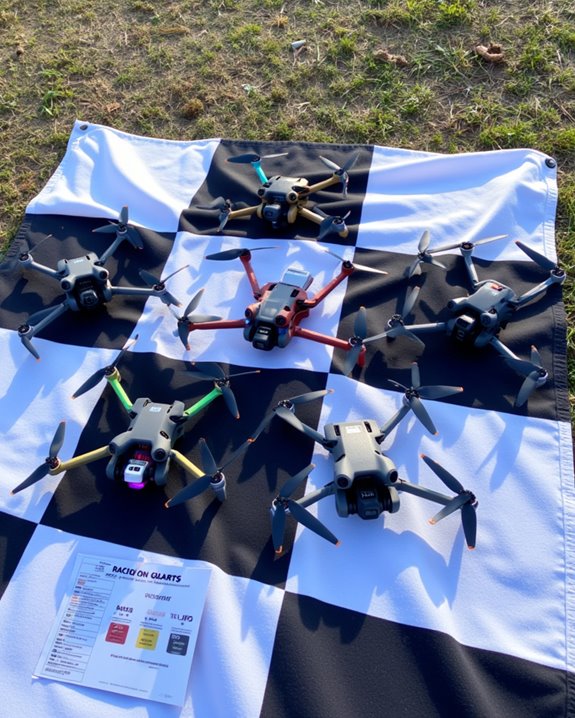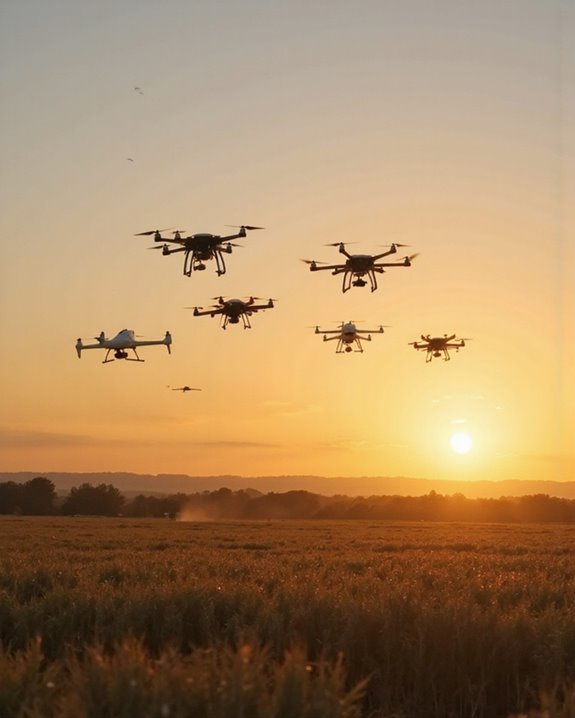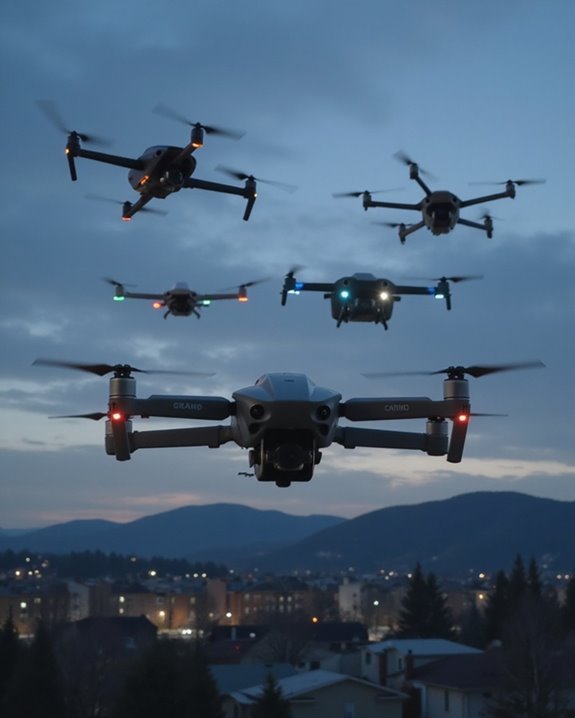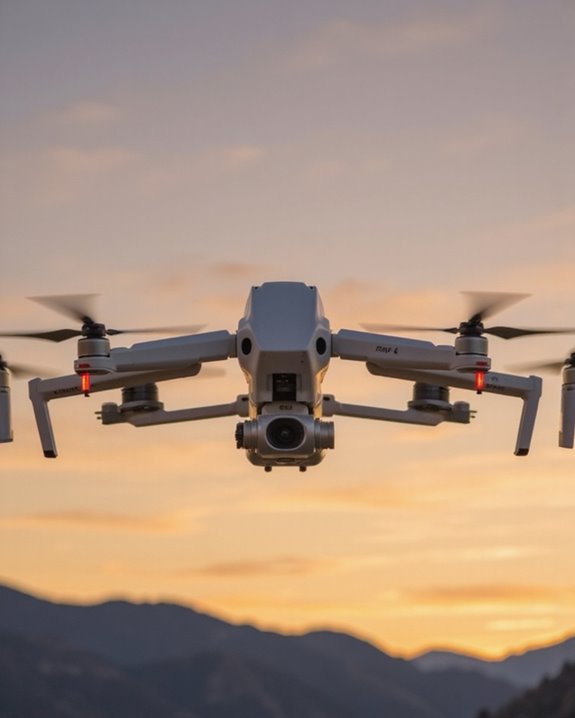You’ll find remarkable innovation in this year’s top FPV racers! The Tiny Hawk boasts a lightweight carbon fiber frame perfect for freestyle tricks, while DJI’s FPV Combo delivers stunning 4K/60fps footage with RockSteady stabilization. For beginners, BETAFPV’s Cetus Pro offers progressive flight modes, and EZ Pilot Pro provides durability with a flexible crash-resistant frame. Don’t overlook the X1 Foldable with its impressive 2.7K camera and 15mph follow capabilities! Explore these speed demons to discover which matches your racing ambitions.
Key Takeaways
- Tiny Hawk offers impressive racing capabilities with its lightweight 79g carbon fiber frame and powerful 7000kv motors for competitive maneuverability.
- DJI FPV delivers high-speed racing at up to 62 mph with comprehensive flight modes (Normal, Sport, Manual) suitable for various skill levels.
- BETAFPV Cetus Pro features three progressive flight modes and speed settings, making it ideal for racers transitioning from beginner to expert.
- EZ Pilot Pro provides precise control through high-quality gimbals with a flexible crash-resistant frame weighing only 32.5g.
- Racing drones feature specialized transmissions (like Tiny Hawk’s adjustable 25/100/200mW VTX) for minimizing latency during high-speed competition flights.
Tiny Hawk Micro Drone Free Style 2 FPV Racing Kit with Goggles and Controller
- Lightweight and Durable
- Strong Carbon Fiber frame
- Real FPV 5.8g
The Tiny Hawk Micro Drone Free Style 2 FPV Racing Kit is a perfect entry point for aspiring drone racers who don’t want to break the bank or sacrifice the real racing experience! Weighing just 79g fully loaded, this carbon fiber lightweight powerhouse comes ready to fly with everything you’ll need—controller, goggles, and two 450mAh batteries.
You’ll appreciate the versatile VTX with switchable power settings (25/100/200mW) and the RunCam Nano 2 camera that delivers 700TVL resolution. Despite some landing glitches and limited battery life, this beginner-friendly kit offers impressive durability for both indoor and outdoor flying. The strong carbon frame handles crashes like a champ, while the 1103 motors with 7000kv deliver surprising zip!
Best For: Beginning drone enthusiasts looking for an affordable all-in-one FPV racing kit that offers both indoor and outdoor flight capabilities with real racing features.
Pros:
- Complete kit includes everything needed to start flying immediately (drone, controller, goggles, batteries, and charger)
- Lightweight but durable carbon fiber frame withstands crashes while maintaining excellent maneuverability
- Versatile VTX with adjustable power settings (25/100/200mW) and 37 channels for flexible racing options
Cons:
- Limited battery life with the included 450mAh 1S batteries that hold minimal charge
- Known to experience glitches specifically during landing procedures
- Video quality is below 720p resolution, which may disappoint users expecting higher definition footage
DJI FPV Combo Drone with 4K Camera
- IMMERSIVE FLIGHT EXPERIENCE: Feel the thrill of immersive flight provided by the DJI FPV Goggles V2 and DJI FPV’s super-wide 150° FOV, giving you an ultra-smooth,...
- FAA Remote ID Compliant - DJI FPV complies with the FAA Remote ID rule. Please check the compliance document below to see the user guide for Remote ID, and you can visit...
- 4K/60FPS VIDEO: The DJI FPV aircraft can record 4K/60fps video at up to 120 Mbps, capturing crisp details that make footage look as exhilarating as the flight.
Designed for pilots seeking an immersive introduction to FPV flying, DJI’s FPV Combo Drone represents a perfect balance between accessibility and high-performance capabilities. You’ll experience the thrill of 150° FOV through the included Goggles V2, with crystal-clear 4K/60fps video capture that makes every flight memorable.
Switch between three intuitive flight modes – N mode for traditional drone controls, S mode for dynamic hybrid flying, and M mode when you’re ready to unlock complete creative freedom! With speeds reaching 62 mph and RockSteady stabilization, you’ll never miss a shot. The thorough safety features, including obstacle sensing and Smart RTH, keep you protected while you push boundaries. The 12-minute flight time might leave you wanting more, but that’s just part of the FPV addiction!
Best For: FPV drone enthusiasts and cinematographers seeking an immersive flying experience with intuitive controls, high-quality 4K video capabilities, and multiple flight modes to accommodate different skill levels.
Pros:
- Immersive 150° FOV goggles with HD low-latency transmission provide a thrilling first-person view flight experience
- Three versatile flight modes (N, S, and M) accommodate beginners through advanced pilots with increasing levels of control
- Comprehensive safety features including obstacle sensing, Smart RTH, and FAA Remote ID compliance
Cons:
- Limited 12-minute flight time per battery requires multiple batteries for extended sessions
- Some users report motion sickness when using the immersive goggles
- At 295 grams, it’s slightly heavier than some comparable drones which may affect maneuverability
BETAFPV Cetus Pro FPV Drone Kit for Beginners
- 【Cetus Pro FPV Kit】BETAFPV Cetus Pro FPV Kit is a brushless whoop drone designed from the ground up for FPV beginners. Auxiliary flight function is available for...
- 【N/S/M 3 Flight Modes】Normal/ Sport/ Manual are available, which can satisfy the different needs of pilots and adapt to various flight environments. Meanwhile, these...
- 【Altitude Hold Function】Altitude hold function enables Cetus Pro brushless quadcopter to Auto-Hover. The quadcopter can stay at a current height when pilots' hands...
Aspiring drone pilots seeking a smooth entry into FPV racing will find their perfect match in the BETAFPV Cetus Pro Kit. This brushless whoop drone features auxiliary flight functions that’ll have you flying confidently from day one, without the usual crash-and-learn method that burns through propellers!
You’ll love the three versatile flight modes—Normal, Sport, and Manual—each with adjustable speeds to match your growing skills. The altitude hold function uses barometer and laser technology to keep you hovering steadily in Normal mode. When things go sideways (literally!), the innovative Turtle Mode flips your drone right-side up with a simple transmitter command, saving you countless retrieval missions from bushes and puddles.
Best For: Beginners who want to learn FPV drone flying with a supportive system that reduces crashes while developing skills through progressive flight modes and speeds.
Pros:
- Three flight modes (Normal, Sport, Manual) with three speed settings in each allow for gradual skill progression
- Altitude hold function with barometer and laser technology provides stable hovering for learning basics
- Turtle Mode automatically flips the drone when it’s upside down, reducing frustrating retrieval missions
Cons:
- Limited to beginner-focused flying characteristics despite “Pro” in the name
- Self-protection features may interrupt flying unexpectedly for safety reasons
- May require transition to more advanced drones once skills progress beyond beginner level
EZ Pilot Pro FPV Drone Set with Real 5.8g Goggles and Controller
- New and Improved EZ Pro with real time FPV feed
- Extremely easy to learn to fly and become a top racing pilot!
- Durable and Flexible frame for MAX durability! Perfect for all ages!
For beginners seeking their first taste of FPV drone racing without breaking the bank, this budget-friendly EZ Pilot Pro set delivers a complete, ready-to-fly experience right out of the box! Released in January 2024, this tiny 32.5g drone packs impressive features, including brushless motors and real-time 5.8g video feed that’ll have you feeling like a pro from day one.
You’ll appreciate the durable, flexible frame that withstands those inevitable learning crashes, while the detachable goggle screen lets you upgrade later. Its 450mAh battery powers smooth flights with precise control from high-quality gimbals. The only minor drawback? The goggles lack DVR recording—but at this price point, who’s complaining?
Best For: Beginners and budget-conscious drone enthusiasts looking to experience FPV (first-person view) racing without a significant investment.
Pros:
- Complete ready-to-fly package including drone, controller, goggles, and battery
- Durable flexible frame that can withstand crashes during the learning process
- Real-time 5.8g video feed provides authentic racing experience with clean video transmission
Cons:
- Goggles lack DVR recording functionality to capture and review flights
- Limited 450mAh battery capacity may result in shorter flight times
- Basic 480p video resolution is lower than more expensive FPV drone systems
X1 Foldable Self-Flying Drone with Camera and Follow Me Mode
- Intelligent Follow-Me Camera: Harnessing advanced tracking algorithms and a following speed of up to 15 mph, the HOVERAir follow-me self-flying drone becomes your...
- Portability and Simplicity Redefined: Weighing a mere 125g (4.41oz), lighter than an iPhone and exempt from the hassle of FAA registration. The foldable design makes...
- Automatic and Intelligent Flight Paths: Experience hands-free flying with the pre-programmed flight paths, including Hover, Follow, Zoom Out, Orbit, Bird’s Eye, Manual...
The X1 Foldable Self-Flying Drone stands out as a perfect companion for active outdoor enthusiasts who don’t want to sacrifice quality footage for portability. At just 125g, you’ll never worry about FAA registration, and its compact design fits right in your pocket!
You’ll love the intelligent tracking that follows you at speeds up to 15 mph, capturing your adventures with 2.7K clarity. Choose from 20 different flight paths per battery charge, including the dramatic orbit mode or bird’s-eye view. The triple stabilization system guarantees your footage stays buttery-smooth, while the enclosed guards keep your drone (and curious fingers) protected. Simply download your epic shots via the app and share your exploits instantly!
Best For: Outdoor enthusiasts, adventure seekers, and sports participants who want hassle-free aerial photography without dealing with complex drone controls or carrying bulky equipment.
Pros:
- Lightweight (125g) and foldable design makes it extremely portable while avoiding FAA registration requirements
- Impressive automated tracking features with 20 intelligent flight paths and Follow-Me mode at speeds up to 15 mph
- High-quality 2.7K video capture with triple stabilization system for smooth footage in active situations
Cons:
- Limited 11-minute battery life per charge may restrict extended filming sessions
- 32GB internal storage cannot be expanded, potentially limiting recording capacity during longer trips
- Does not mention weather resistance or wind tolerance, suggesting potential limitations in adverse conditions
Factors to Consider When Choosing an FPV Racing Drone

Selecting the perfect FPV racing drone can feel overwhelming with so many specs to evaluate, but focusing on key factors will make your decision much easier! You’ll want to carefully evaluate weight, frame durability, flight controller capabilities, motor power, and battery life to match your racing style and skill level. When these elements align with your specific needs, you’ll experience the thrill of precision flying while avoiding the frustration of owning a drone that doesn’t quite suit your racing ambitions.
Weight and Portability
Lightweight champions of the sky, FPV racing drones offer dramatically different flight experiences depending on their weight class. You’ll feel the difference between a nimble 50-gram speedster and a 250-gram powerhouse the moment you take flight! Sub-100 gram models deliver exceptional agility and reduced wind resistance, letting you slice through air with buttery-smooth precision.
Looking to travel with your drone? Consider models under 250 grams, which often dodge regulatory hurdles that would otherwise clip your wings. Foldable frames are your best friend for on-the-go adventures, shrinking your racing machine to backpack-friendly dimensions. Remember, lighter drones (50-80 grams) typically offer more bang for your battery buck, extending your airtime while maintaining that razor-sharp responsiveness that separates the podium finishers from the pack!
Frame Material Durability
Carbon fiber frames dominate the FPV racing scene for good reason – they’re practically indestructible when you’re pushing limits at breakneck speeds! You’ll notice top racers choose frames with tensile strength exceeding 3000 MPa, giving you confidence to execute those hair-raising turns without fear of shattering your investment.
Your frame’s durability directly impacts how many races you’ll complete before needing replacements. Look for composite materials under 50 grams that absorb impacts rather than crack on contact – your wallet will thank you! The best frames balance that magical strength-to-weight ratio, allowing you to accelerate faster while bouncing back from the occasional wall tap. Remember, in FPV racing, it’s not if you’ll crash, but when! Choose materials that forgive your mistakes while keeping you competitive through countless flight sessions.
Flight Controller Capabilities
The beating heart of your racing drone, a flight controller makes all the difference between victory and crashing into barriers! Today’s controllers pack impressive processing power—often several hundred MHz—ensuring your drone responds instantly to every stick movement during those hairpin turns.
You’ll appreciate the flexibility of multiple flight modes, switching between stability-focused normal mode for practice and manual mode when you’re ready to tackle complex racing maneuvers. The best controllers integrate precise sensors that maintain altitude within centimeters, letting you focus on speed rather than fighting drift.
Don’t overlook customization options! Adjustable PID settings let you fine-tune your drone’s responsiveness, eliminating those wobbly oscillations that slow you down. For ultimate performance, look for models with integrated ESCs supporting 8kHz refresh rates—your motors will thank you with butter-smooth acceleration when every millisecond counts!
Motor Power Specifications
Selecting the perfect motors for your FPV racing drone might be the single most crucial decision you’ll make when building your speed machine! The KV rating should be your first consideration—higher values deliver blistering acceleration and top speeds that’ll leave competitors in your dust. Your motor’s stator size directly impacts torque, with larger stators providing the muscle needed for aggressive maneuvers and maintaining stability through tight turns.
Don’t overlook efficiency factors, as proper winding resistance converts more electricity into pure thrust, extending your precious flight time. You’ll want a thrust-to-weight ratio that gives your drone that magical feeling of unlimited power! Brushless motors are non-negotiable for serious racers, offering superior power density and longevity that’ll keep you competitive race after race. Choose wisely—your podium finishes depend on it!
Battery Life Duration
Understanding battery life represents the difference between finishing that perfect racing lap or watching your drone drop from the sky mid-competition! Most FPV racing drones offer 10-15 minutes of flight time per charge, which can feel surprisingly short when you’re in the zone.
If you’re seeking maximum airtime, look for models with higher capacity batteries around 450mAh, which typically deliver 11-12 minutes under normal conditions. Remember, your flying style dramatically affects battery consumption—those thrilling high-speed modes and aggressive maneuvers will drain power faster than casual cruising! Don’t overlook the drone’s weight either, as lighter builds generally stay airborne longer.
Smart racers also consider recharge times between flights. Nothing kills race day momentum like waiting hours for batteries to juice up, so plan accordingly!
Video Transmission Quality
Why risk losing that winning position because your video feed stuttered at the worst possible moment? When racing at breakneck speeds, your video transmission system is your lifeline to victory! The best FPV racing drones deliver ultra-low latency under 20 milliseconds, giving you the real-time responsiveness needed for those split-second decisions.
Look for systems operating on the 5.8GHz band with multiple race channels to slash interference and keep your signal rock-solid. You’ll want adjustable transmission power (25mW-200mW) to match your flying environment—lower for crowded race days, higher for open courses. And don’t underestimate resolution! A crisp 720p or 1080p feed means spotting that tight gate before your competitors even see it. Features like frequency hopping can be absolute lifesavers when interference tries to ruin your perfect run!
Control System Responsiveness
While video quality keeps you informed, your control system’s responsiveness transforms that information into racing dominance! In competitive racing, milliseconds matter—aim for systems with latency under 50ms to nail those hairpin turns with precision.
Today’s digital systems deliver lightning-fast responsiveness (under 20ms), leaving older analog setups (100ms+) in the dust. Your flight controller’s processing speed is equally essential, as faster chips handle your inputs more efficiently when you’re blazing through gates at top speed!
Look for drones featuring adaptive responsiveness with adjustable gain settings, allowing you to customize the feel to match your personal flying style. Whether you’re carving aggressive turns or executing delicate maneuvers, a responsive control system isn’t just nice to have—it’s the difference between podium finishes and watching from the sidelines!
Frequently Asked Questions
How Long Does It Take to Become Proficient at FPV Racing?
You’ll need a million hours to master FPV racing! Just kidding – most pilots become reasonably proficient within 3-6 months of consistent practice. You’ll start with basics like hovering and simple maneuvers, then gradually progress to racing lines and competitive techniques. Your learning curve depends on how frequently you practice, whether you use simulators, and if you have mentorship from experienced racers. Stick with it through those inevitable crashes, and you’ll be zipping through gates with confidence before you know it!
Are FPV Racing Drones Legal to Fly in Residential Areas?
Flying FPV racing drones in residential areas is complicated! You’ll need to follow FAA regulations, which include registering drones over 0.55 pounds, maintaining visual line-of-sight, and staying below 400 feet. Most residential neighborhoods aren’t suitable for racing speeds, as you’re not allowed to fly over people or moving vehicles. Your best bet? Join a local drone club with designated flying areas, or find empty fields away from homes. Remember, those neighbors probably don’t share your enthusiasm for high-pitched buzzing overhead!
What’s the Average Lifespan of a Racing Drone Before Requiring Repairs?
Time flies when you’re racing drones, but unfortunately, so does their lifespan! You can expect your average racing drone to last about 3-6 months of regular use before needing some repairs. The most common components that wear out first are motors, propellers, and frames due to crashes. With proper maintenance and careful flying, you’ll extend your drone’s life greatly. Many racers keep spare parts handy, as replacing a damaged component is simply part of the hobby!
Can I Use My Smartphone Instead of FPV Goggles?
Yes, you can use your smartphone instead of FPV goggles, but it’s not ideal for racing. Most racing drones connect to smartphones through apps like FPV Viewer or WiFi, offering a budget-friendly start. However, you’ll experience noticeable latency issues and a narrower field of view, which is vital when you’re zipping around obstacles at high speeds! For casual flying, your phone works fine, but competitive racers always choose goggles for their immersive experience and real-time responsiveness.
How Fast Do Competitive FPV Racing Drones Typically Fly?
Competitive FPV racing drones are seriously quick! You’ll typically see these speed demons flying between 70-90 mph during races, with the most elite builds reaching a jaw-dropping 120+ mph in straightaways. The average race speed hovers around 80 mph as pilots navigate through gates, flags, and tight turns. Your reflexes need to be lightning-fast to handle these machines, which is why dedicated FPV goggles (not smartphones) are essential for the split-second reactions required at these thrilling velocities!










